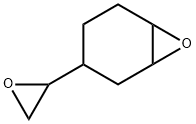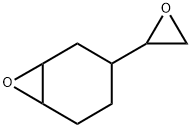4-Vinylcyclohexene dioxide
Synonym(s):1,2-Epoxy-4-epoxyethylcyclohexane;3-Epoxyethyl-7-oxabicyclo[4.1.0]heptane;4-vinyl-1-cyclohexene diepoxide
- CAS NO.:106-87-6
- Empirical Formula: C8H12O2
- Molecular Weight: 140.18
- MDL number: MFCD00022354
- EINECS: 203-437-7
- SAFETY DATA SHEET (SDS)
- Update Date: 2025-01-27 09:38:02

What is 4-Vinylcyclohexene dioxide?
Chemical properties
colourless liquid. Combustible.
Chemical properties
Vinyl cyclohexene dioxide is a colorless liquid
The Uses of 4-Vinylcyclohexene dioxide
Vinylcyclohexene dioxide (VCD) is used to study toxicity as an ovotoxin,and it's also used to understand its mechanisms of toxicity towards ovarian follicles and effects on epithelial differentiation.
The Uses of 4-Vinylcyclohexene dioxide
As a chemical intermediate and as a reactive diluent for diepoxides and epoxy resins.
The Uses of 4-Vinylcyclohexene dioxide
Vinylcyclohexene dioxide (VCD) may be used to study and understand its effect on ovarian follicles and effects on epithelial differentiation.
What are the applications of Application
Vinylcyclohexene dioxide is A biochemical used to study ovotoxicity
Definition
ChEBI: The diepoxide of 4-vinylcyclohexene.
Production Methods
VCHD is manufactured by epoxidation of 4-vinylcyclohexene with peroxyacetic acid .
General Description
Clear colorless liquid. Sets to glass at -67°F. Faint olefinic odor.
Air & Water Reactions
Water soluble. Hydrolyzes slowly in water.
Reactivity Profile
4-VINYLCYCLOHEXENE DIOXIDE reacts with active hydrogen compounds (such as alcohols and amines). . Epoxides are highly reactive. They polymerize in the presence of catalysts or when heated. These polymerization reactions can be violent. Compounds in this group react with acids, bases, and oxidizing and reducing agents. They react, possibly violently with water in the presence of acid and other catalysts.
Hazard
Toxic by ingestion and skin absorption, strong irritant to skin and tissue. Female and male reproductive damage. Possible carcinogen.
Health Hazard
Vinyl cyclohexene dioxide (VCD) is an irritant to the skin, eyes, and respiratory system. It is ovotoxic and carcinogenic in experimental animals.
Safety Profile
Confirmed carcinogen with experimental carcinogenic and tumorigenic data. Poison by unspecified route. Moderately toxic by ingestion and skin contact. Mildly toxic by inhalation. Experimental reproductive effects. Mutation data reported. A severe skin irritant.Combustible when exposed to heat or flame. To fight fire, use water, foam, dry chemical. When heated to decomposition it emits acrid smoke and irritating fumes.
Potential Exposure
This material is used as a monomer in the production of epoxy resins for coatings and adhesives; as a chemical intermediate and as a reactive diluent.
Carcinogenicity
4-Vinyl-1-cyclohexene diepoxide is reasonably anticipated to be a human carcinogen based on sufficient evidence of carcinogenicity fromstudies in experimental animals.
Shipping
UN2810 Toxic liquids, organic, n.o.s., Hazard Class: 6.1; Labels: 6.1-Poisonous materials, Technical Name Required.
Incompatibilities
When heated or in contact with catalysts, epoxides may cause violent polymerization. Epoxides are incompatible with reducing agents and oxidizers (chlorates, nitrates, peroxides, permanganates, perchlorates, chlorine, bromine, fluorine, etc.); contact may cause fires or explosions. Keep away from alkaline materials, strong bases, strong acids, oxoacids, epoxides. May react, possibly violently, with water in the presence of acid and other catalysts. Reacts with alcohols, amines and other active hydrogen compounds. Slowly hydrolyzes in water.
Waste Disposal
Concentrated waste containing no peroxides: discharge liquid at a controlled rate near a pilot flame. Concentrated waste containing peroxides: perforation of a container of the waste from a safe distance followed by open burning.
Properties of 4-Vinylcyclohexene dioxide
| Melting point: | -55°C |
| Boiling point: | 230-232 °C(lit.) |
| Density | 1.094 g/mL at 25 °C(lit.) |
| refractive index | n |
| Flash point: | 225 °F |
| storage temp. | under inert gas (nitrogen or Argon) at 2-8°C |
| form | Colorless or pale yellow
liquid |
| Water Solubility | 154.7g/L(20 ºC) |
| BRN | 106071 |
| Stability: | Stable. Combustible. Incompatible with strong oxidizing agents, alcohols, amines and other compounds containg an active hydrogen. Hydrolyzes slowly in water. |
| CAS DataBase Reference | 106-87-6(CAS DataBase Reference) |
| IARC | 2B (Vol. Sup 7, 60) 1994 |
| EPA Substance Registry System | 4-Vinylcyclohexene diepoxide (106-87-6) |
Safety information for 4-Vinylcyclohexene dioxide
| Signal word | Danger |
| Pictogram(s) |
 Skull and Crossbones Acute Toxicity GHS06  Health Hazard GHS08 |
| GHS Hazard Statements |
H351:Carcinogenicity |
| Precautionary Statement Codes |
P201:Obtain special instructions before use. P280:Wear protective gloves/protective clothing/eye protection/face protection. |
Computed Descriptors for 4-Vinylcyclohexene dioxide
New Products
3-Iodophenylacetic acid 3-Pyridineacetonitrile, α-hydroxy- 2-Propanamine, 1-chloro-, hydrochloride (9CI) 3-(hexyloxy)-4-(pyridin-3-yl)-1,2,5-thiadiazole 2-Hexyn-1-ol Dibenzo-18-crown-6 Nickel(II) perchlorate hexahydrate, 98% 4-Bromophenylacetonitrile, 95% 3-Bromo-4-fluoroaniline, 97% Sodium tetraborate decahydrate, 98% Palladium(II) acetate, trimer, Pd 99% 4-Bromo-2-chlorotoluene, 97% N N Dimethylformamide Dimethyl Acetal (Dmf Dma) 2,3-Dichloro Benzoyl Cyanide [Side Chain] Bis(2-Chloroethyl) Amine Hydrochloride L-Glutamic Acid Diethyl Ester Hydrochloride 5-(Difluoromethoxy)-2-Mercaptobenzimidazole 1-Ethyl-3-(3-Dimethylaminopropyl)-Carbodiimide Hydrochloride [EDC Hcl] 1,4-Napthoquinone Bromoiodomethane Sodium Bicarbonate Methylene Dichloride (MDC) Ethyl Acetate Indole-3-Carbinol (I3C)Related products of tetrahydrofuran
![3-(oxiran-2-yl)-7-oxabicyclo[4.1.0]heptane](https://img.chemicalbook.in/CAS/GIF/73752-15-5.gif)




![1-METHYL-4-(2-METHYLOXIRANYL)-7-OXABICYCLO[4.1.0]HEPTANE](https://img.chemicalbook.in/CAS/GIF/96-08-2.gif)


You may like
-
 Vinylcyclohexene dioxide CAS 106-87-6View Details
Vinylcyclohexene dioxide CAS 106-87-6View Details
106-87-6 -
 17604-74-9 3-Pyridineacetonitrile, α-hydroxy- 98+View Details
17604-74-9 3-Pyridineacetonitrile, α-hydroxy- 98+View Details
17604-74-9 -
 131987-69-4 98+View Details
131987-69-4 98+View Details
131987-69-4 -
 Cyclohexane, (2-propynyloxy)- 67967-07-1 98+View Details
Cyclohexane, (2-propynyloxy)- 67967-07-1 98+View Details
67967-07-1 -
 764-60-3 2-Hexyn-1-ol 98+View Details
764-60-3 2-Hexyn-1-ol 98+View Details
764-60-3 -
 2-Propanamine, 1-chloro-, hydrochloride (9CI) 98+View Details
2-Propanamine, 1-chloro-, hydrochloride (9CI) 98+View Details
5968-21-8 -
 3-Iodophenylacetic acid 1878-69-9 98+View Details
3-Iodophenylacetic acid 1878-69-9 98+View Details
1878-69-9 -
 132945-75-6 (S)-1-Boc-3-methanesulfonyloxy-pyrrolidine 98+View Details
132945-75-6 (S)-1-Boc-3-methanesulfonyloxy-pyrrolidine 98+View Details
132945-75-6
